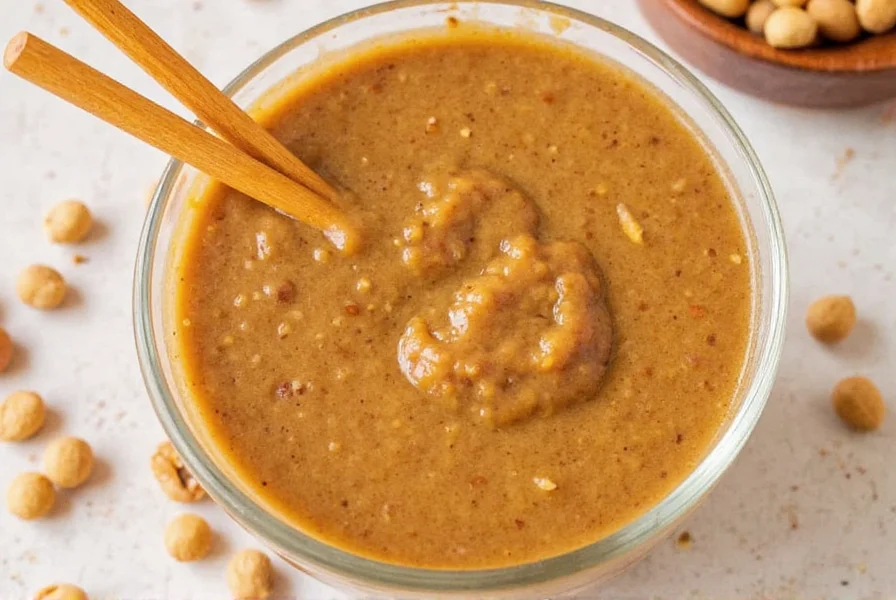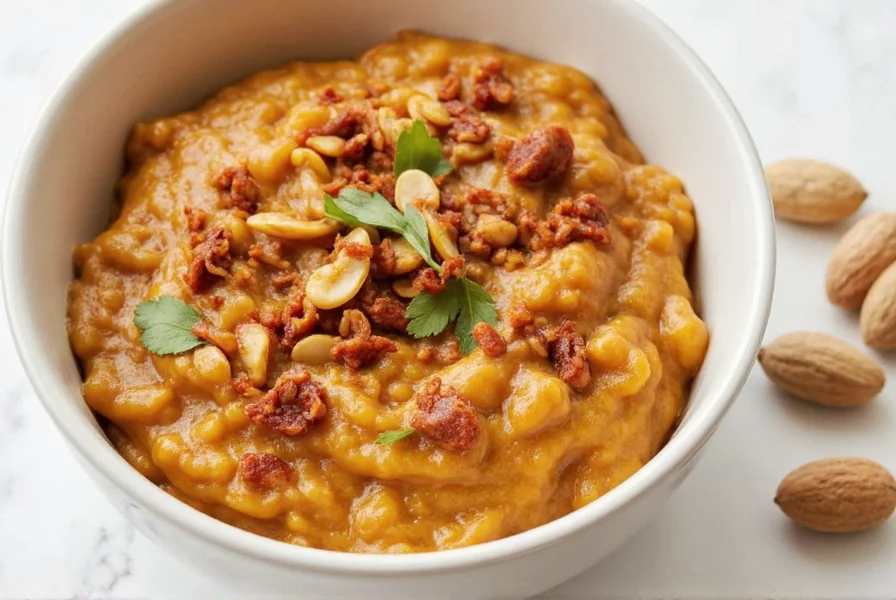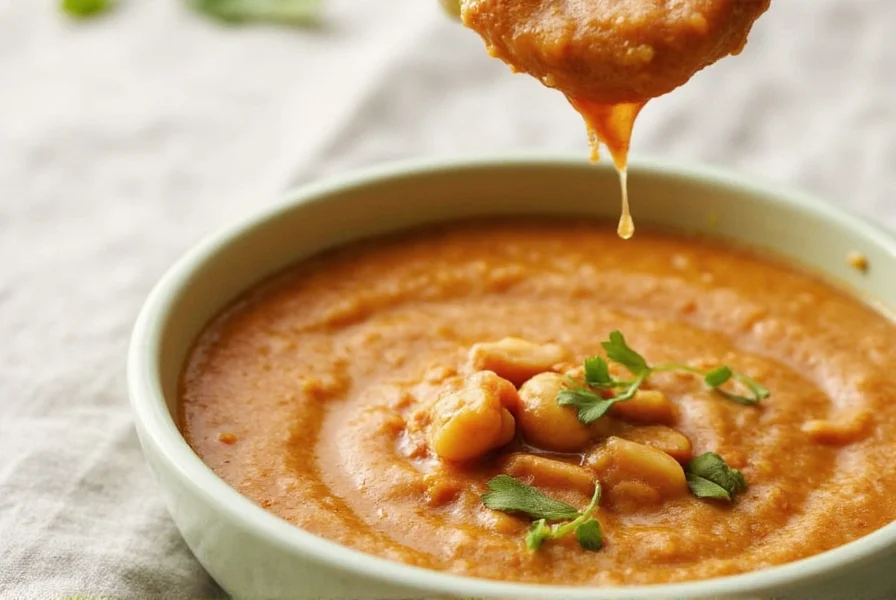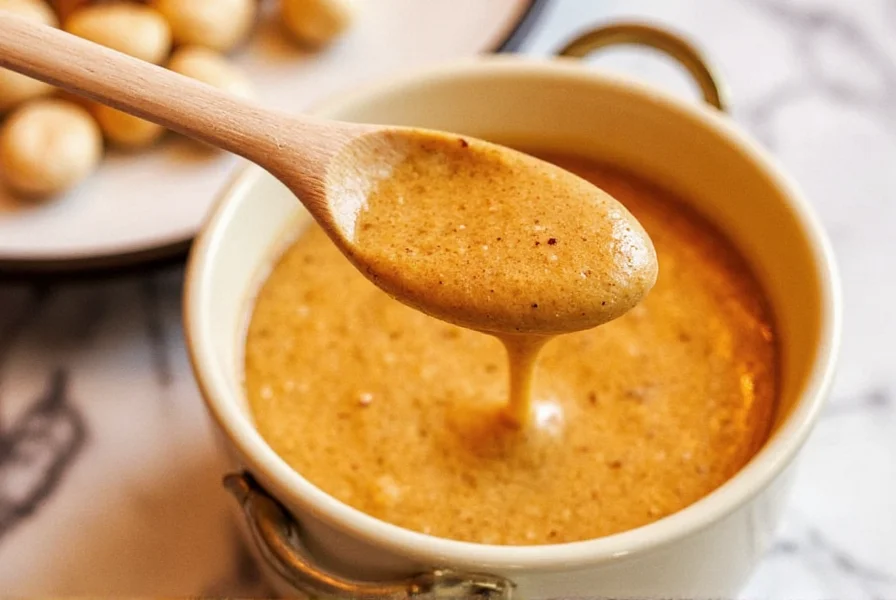Discover the perfect satay sauce recipe with peanuts for your next BBQ or snack. This easy-to-follow guide includes step-by-step instructions, regional variations, and 5 creative upgrades to elevate your dish.
Basic Satay Sauce Recipe with Peanuts
Ingredients:
- 1/2 cup smooth natural peanut butter
- 1/4 cup coconut milk
- 1 tbsp soy sauce
- 1 tbsp rice vinegar or lime juice
- 1 clove garlic, minced
- 1 tsp grated fresh ginger
- 1–2 tsp crushed red pepper flakes (adjust to taste)
- 1 tbsp brown sugar or palm sugar
- 2 tbsp water (or more to adjust consistency)
Instructions:
- In a small saucepan over low heat, combine all ingredients except water.
- Stir continuously until warm and well-blended.
- Add water to reach your desired thickness — thick for dipping, thinner for drizzling or marinating.
- Taste and adjust seasoning — more sugar for sweetness, more vinegar for tanginess, more chili for kick!

What Is Satay Sauce?
Satay sauce — often mistaken for regular peanut sauce — is the soul of satay, Southeast Asia's beloved grilled meat skewers. While recipes vary by region, most versions include a base of ground peanuts, coconut milk or cream, soy sauce, garlic, ginger, chili, and aromatic spices like coriander and cumin. Unlike generic peanut sauces found in Western takeout, authentic satay sauce strikes a delicate balance between sweet, salty, spicy, and umami — with peanuts playing the starring role.
Historically, satay has been enjoyed in Malaysia, Indonesia, Thailand, and Singapore for centuries. The sauce varies subtly from country to country:
| Country | Key Ingredients | Flavor Profile |
|---|---|---|
| Malaysia | Peanut butter, coconut milk, lemongrass, galangal | Sweet, aromatic, mildly spicy |
| Indonesia | Ground roasted peanuts, kecap manis, tamarind | Dark, molasses-like sweetness with tangy depth |
| Thailand | Peanuts, fish sauce, lime juice, bird's eye chilies | Spicy, sour, and bold |
| Singapore | Creamy peanut base, palm sugar, turmeric | Smooth, balanced, slightly floral |
5 Creative Ways to Elevate Your Satay Sauce
If you're tired of the same old peanut sauce routine, try one (or all!) of these inventive twists on the traditional satay sauce recipe with peanuts:
1. Coconut Curry Kick
 Add 1 teaspoon of Thai red curry paste or yellow curry powder to your basic sauce. It gives it a deeper, spicier backbone that pairs beautifully with chicken, shrimp, or tofu satay.
Add 1 teaspoon of Thai red curry paste or yellow curry powder to your basic sauce. It gives it a deeper, spicier backbone that pairs beautifully with chicken, shrimp, or tofu satay.
2. Sesame Soy Drizzle
Swap out half the peanut butter with toasted sesame butter and add an extra splash of soy sauce and toasted sesame oil. This creates a rich, nutty variation perfect for noodle bowls and veggie wraps.
3. Cilantro-Lime Zing
Blend in a handful of fresh cilantro and a squeeze of lime for a vibrant green twist. Ideal for taco nights or zesty seafood dishes. Bonus: it looks amazing drizzled over grilled veggies!
4. Sriracha Honey Heatwave
Mix in 1 tablespoon sriracha and 1 teaspoon honey for a sweet-and-spicy version that's great for wings, burgers, or even fries. This flavor bomb adds instant street-food flair to any snack or appetizer.
5. Miso Magic
Whisk in 1 teaspoon of white miso paste for a subtle umami boost. This upgrade works especially well when serving satay alongside Japanese or Korean-inspired dishes like yakitori or bulgogi.
Buying Guide: Must-Have Ingredients for Perfect Satay Sauce
The magic of a great satay sauce recipe with peanuts lies not just in technique but also in choosing quality ingredients. Here are some top picks to elevate your next batch:
| Product | Features | Advantages | Best For | When to Use |
|---|---|---|---|---|
| Artisan Organic Peanut Butter | No added sugar or oil, stone-ground texture | Richer flavor, smoother blend | Classic satay lovers | Dipping sauces, marinades |
| Full-Fat Coconut Milk (Aseptic Pouch) | High-fat content, no preservatives | Creates a silky, indulgent texture | Vegetarian and vegan cooks | Curries, sauces, soups |
| Red Boat Fish Sauce | Single-ingredient anchovy fermentation | Deep umami without salt overload | Thai-style satay enthusiasts | Adding complexity to savory sauces |
| Kecap Manis (Sweet Soy Sauce) | Thicker than regular soy, infused with palm sugar | Brings Indonesian richness and shine | Balinese or Javanese satay fans | Glazes, marinades, stir-fries |
| Roasted Ground Peanuts | Unsalted, finely ground, no additives | For texture and depth in homemade blends | DIY chefs and foodies | Custom sauces and garnishes |
 These products are ideal for anyone serious about crafting restaurant-quality flavors at home. Look for them in gourmet markets, health food stores, or online specialty retailers.
These products are ideal for anyone serious about crafting restaurant-quality flavors at home. Look for them in gourmet markets, health food stores, or online specialty retailers.
Frequently Asked Questions About Satay Sauce
Is satay sauce the same as peanut sauce?
While often used interchangeably, authentic satay sauce is distinct from generic peanut sauce. Traditional satay sauce originates from Southeast Asia and specifically accompanies grilled meat skewers (satay). It typically contains coconut milk, specific spices like galangal or lemongrass depending on the region, and achieves a precise balance of sweet, salty, spicy, and umami flavors. Western "peanut sauce" is often a simplified version that may lack these regional nuances.
Can I make satay sauce without coconut milk?
Yes, you can substitute coconut milk with several alternatives. For a similar creamy texture, try cashew cream (soak 1/4 cup raw cashews in hot water for 15 minutes, then blend with 1/4 cup water until smooth), Greek yogurt (for non-vegan option), or even vegetable broth for a lighter version. Keep in mind that coconut milk contributes significantly to the authentic Southeast Asian flavor profile, so the substitute will create a different variation of peanut sauce rather than traditional satay sauce.
How long does homemade satay sauce last?
Homemade satay sauce will keep for 3-4 days in an airtight container in the refrigerator. For longer storage, freeze in ice cube trays then transfer the frozen cubes to a freezer bag - it will maintain quality for up to 3 months. Always reheat thoroughly before serving. Note that sauces containing fresh ingredients like garlic or ginger may have a slightly shorter shelf life than those using powdered forms.
Is satay sauce gluten-free?
Most traditional satay sauce recipes can be gluten-free, but you must check your ingredients carefully. Soy sauce typically contains wheat, so use tamari or a certified gluten-free soy sauce instead. Some store-bought peanut butters may contain gluten additives, so choose a natural variety with just peanuts and salt. Always verify all ingredient labels if you're preparing for someone with celiac disease or severe gluten sensitivity.
What are the best proteins to serve with satay sauce?
While traditionally served with chicken, beef, or lamb skewers, satay sauce pairs wonderfully with many proteins. Chicken thighs (for their fat content which complements the rich sauce), shrimp, tofu, tempeh, pork tenderloin, and even fish like salmon all work beautifully. For vegetarian options, try it with grilled portobello mushrooms or eggplant. The sauce also makes an excellent dipping sauce for spring rolls or as a dressing for noodle salads.
Can I make this recipe nut-free for allergies?
Yes, you can create a nut-free version using sunflower seed butter as a substitute for peanut butter. The flavor profile will differ slightly but will still provide a rich, creamy base. For more authentic Southeast Asian flavors, try using roasted pumpkin seeds (pepitas) ground fine with coconut milk. Some Southeast Asian restaurants traditionally use ground beans or lentils in certain regions where peanuts weren't historically available. Just be sure to label nut-free versions clearly if serving to others with allergies.
Final Thoughts
A satay sauce recipe with peanuts is more than just a condiment — it's a gateway to the vibrant world of global spice traditions. From its humble origins in Southeast Asia to its modern-day variations around the world, satay sauce remains a symbol of comfort, culture, and culinary creativity.
Whether you stick to the classic formula or experiment with new flavors, remember: the best satay sauce is the one that makes your taste buds dance. So fire up that grill, skewer your favorite protein, and let your upgraded satay sauce steal the show.
 Now go forth and get saucy — your dinner guests will thank you!
Now go forth and get saucy — your dinner guests will thank you!










 浙公网安备
33010002000092号
浙公网安备
33010002000092号 浙B2-20120091-4
浙B2-20120091-4